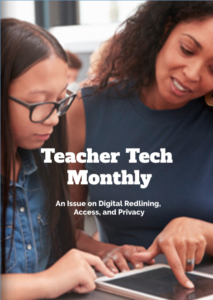This week the assignment was to read about digital redlining through the voice of Chris Gilliard. He presents information about why digital media is a topic that students should be educated on, and why not finding the information you are looking for doesn’t mean it’s not there. I decided a fun way to display my opinion and the opinion of others would be as an online magazine. The magazine is traditional in the sense that there are ads, top lists, articles, a Q & A column, and much more. You can find my opinion of digital redlining and accessibility on page 7 & 8.
I had never heard of the concept of digital redlining before, but I knew about restrictions imposed by schools. My school for undergrad had weird websites that would become blocked on occasion, such as the schools own website. When I am at placement social media websites are blocked, which can make it very hard to message others if you are using messenger to communicate. At Windsor I have not experienced digital redlining, which I am thankful for. Seeing as my internet at my apartment has been down during this project I was glad to not have any restricted access while I would work at Windsor.
In Gillard’s article I was intrigued that this issue seems to stem from money. This does not surprise me, but people making the conscious decision to restrict someones access because they can’t afford the more expensive schooling is unfair. Employers might miss out on great candidates simply because they didn’t have all of the tools they needed to make them stand out. The more Gillard discussed digital redlining the more of a problem I had with this concept. My problem was that I was understanding this for the first time and I knew how wrong this was. Another major problem I had with digital redlining was that sometimes people don’t know it is happening. People may be informed they are missing out on information by getting an access denied message, while others will just never know. Sure, we can try and change digital redlining, but how can some if they don’t even know that it is happening.
I decided to create a free online magazine, because that is something that is accessible to everyone. If I made people pay to read my magazine I would be creating my own digital redlining on a project about how bad digital redlining is. Rather then restrict something because someone can’t afford the product, I wanted to combat digital redlining the one way I thought I could. By creating a free resource for all.
In my classroom I will educate students about this concept. If they know about this concept maybe they will try and combat digital redlining. I want to create students that are passionate for change and creating equal opportunities. I will educate my students about the importance of not letting others hold them back because of restrictions they may have put on them. I want my students to see their ability in the tech world and real world, and make connections between the two. 
Click on the link below to check out the first edition of Teacher Tech Monthly!
https://www.flipsnack.com/9E5C7F7D75E/teacher-tech-monthly.html
Thanks,
Steph
